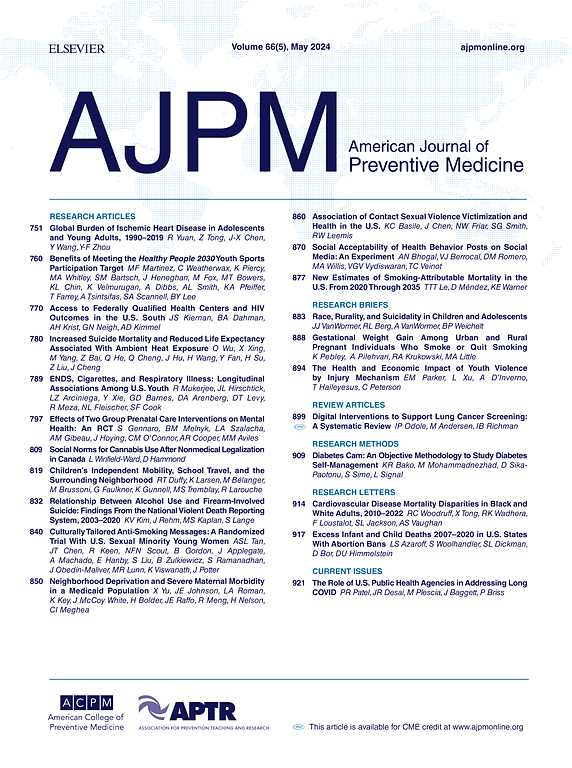在美国军人家庭中,儿童疫苗限制到23个月。
IF 4.5
2区 医学
Q1 MEDICINE, GENERAL & INTERNAL
引用次数: 0
摘要
导言:最近的工作报告在美国军人家庭中完成儿科联合7种疫苗系列方面存在差距;疫苗犹豫作为造成这些差距的一个因素的作用还没有得到很好的理解。本研究旨在评估疫苗限制(接种少于推荐的疫苗)作为与军队有关联的儿童疫苗接种不足的决定因素,并确定疫苗限制的特征。方法:使用国防部出生和婴儿健康研究项目的数据来识别和跟踪2010年至2019年在军队医院出生的一组儿童。到23个月的疫苗接种模式按有限的疫苗访问频率(即接种1-2种疫苗的访问)进行分类。修正的泊松回归模型估计了疫苗限制模式与24个月时未完成7种联合疫苗系列之间的关联。结果:在275,967名与军队有关的儿童中,一致性疫苗限制(所有有限访问)的患病率为0.7%,而偶发性疫苗限制(≥2次有限访问)的患病率为0.7%。结论:很少有美国军人父母持续或偶发性限制早期儿童疫苗,尽管这两种模式都与疫苗接种不足的高风险相关。研究结果表明,在这一人群中需要更多地关注疫苗犹豫。本文章由计算机程序翻译,如有差异,请以英文原文为准。
Pediatric Vaccine Limiting Through Age 23 Months Among U.S. Military Families
Introduction
Recent work reported gaps in completion of the pediatric combined 7-vaccine series among U.S. military families; the role of vaccine hesitancy as a contributor to these gaps is not well understood. This study aimed to assess vaccine limiting (receipt of fewer than recommended vaccines) as a determinant of undervaccination among military-connected children and identify characteristics of vaccine limiting.
Methods
Department of Defense Birth and Infant Health Research program data were used to identify and follow a cohort of children born at military hospitals from 2010 through 2019. Vaccination patterns through age 23 months were categorized by the frequency of limited vaccine visits (i.e., visits with 1–2 vaccines administered). Modified Poisson regression models estimated the associations between vaccine-limiting patterns and noncompletion of the combined 7-vaccine series by age 24 months.
Results
Among 275,967 military-connected children, the prevalence of consistent vaccine limiting (all limited visits) was 0.7%, and that of episodic vaccine limiting (≥2 limited visits and <3 visits with ≥3 vaccines) was 3.6%. Consistent vaccine limiters were more likely to be born to an older pregnant parent and a military sponsor with at least a bachelor’s degree than vaccine nonlimiters. Consistent and episodic vaccine limiting were associated with 3.9 (95% CI=3.8, 4.0) and 2.4 (95% CI=2.4, 2.5) times the risk of noncompletion, respectively, relative to nonlimiting.
Conclusions
Few U.S. military parents consistently or episodically limited early childhood vaccines, although both patterns were associated with higher risk for undervaccination. Findings suggest that greater attention to vaccine hesitancy is needed in this population.
求助全文
通过发布文献求助,成功后即可免费获取论文全文。
去求助
来源期刊

American Journal of Preventive Medicine
医学-公共卫生、环境卫生与职业卫生
CiteScore
8.60
自引率
1.80%
发文量
395
审稿时长
32 days
期刊介绍:
The American Journal of Preventive Medicine is the official journal of the American College of Preventive Medicine and the Association for Prevention Teaching and Research. It publishes articles in the areas of prevention research, teaching, practice and policy. Original research is published on interventions aimed at the prevention of chronic and acute disease and the promotion of individual and community health.
Of particular emphasis are papers that address the primary and secondary prevention of important clinical, behavioral and public health issues such as injury and violence, infectious disease, women''s health, smoking, sedentary behaviors and physical activity, nutrition, diabetes, obesity, and substance use disorders. Papers also address educational initiatives aimed at improving the ability of health professionals to provide effective clinical prevention and public health services. Papers on health services research pertinent to prevention and public health are also published. The journal also publishes official policy statements from the two co-sponsoring organizations, review articles, media reviews, and editorials. Finally, the journal periodically publishes supplements and special theme issues devoted to areas of current interest to the prevention community.
 求助内容:
求助内容: 应助结果提醒方式:
应助结果提醒方式:


